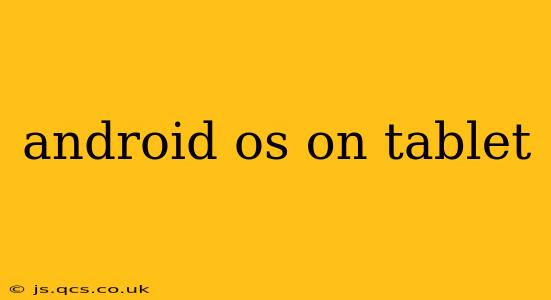Android, the ubiquitous mobile operating system, has firmly established itself as a dominant force in the tablet market. But what makes Android so suitable for tablets, and what are the nuances of its performance on larger screens? This comprehensive guide delves into the specifics of Android OS on tablets, exploring its strengths, weaknesses, and future prospects.
What are the Key Features of Android on Tablets?
Android's success on tablets stems from its adaptability and extensive feature set. Key features optimized for larger screens include:
- Multitasking: Android tablets excel at multitasking. Split-screen functionality allows users to run two apps simultaneously, boosting productivity. Picture-in-picture mode enables viewing videos or video calls while simultaneously using other apps. This seamless multitasking is a significant advantage over some competing operating systems.
- Enhanced User Interface: Android's interface adapts beautifully to the larger tablet screen real estate. Widgets, larger icons, and improved navigation make interaction intuitive and effortless. The overall experience is designed for comfortable and efficient use on a larger display.
- Access to the Google Ecosystem: Tablets running Android seamlessly integrate with other Google services like Gmail, Google Drive, YouTube, and Google Maps. This interconnectivity provides a unified digital experience across devices.
- App Variety: The Google Play Store boasts a vast library of apps optimized for tablets, offering a wide array of functionalities, from productivity tools and entertainment apps to creative suites and gaming experiences. While not all apps are perfectly optimized, the sheer number available provides considerable choice.
- Customization: Android's open-source nature allows for a high degree of customization. Users can personalize their home screens, widgets, and overall appearance to suit their preferences. This level of personalization is a key differentiator for many users.
What are the Differences Between Android on Phones and Tablets?
While sharing the same core Android OS, phone and tablet versions exhibit key distinctions:
- Screen Size & Resolution: This is the most obvious difference. Tablets offer significantly larger screens and higher resolutions, requiring UI adjustments for optimal usability. This impacts app layouts, text sizes, and overall interface design.
- App Optimization: While many apps work seamlessly across both devices, some apps are specifically optimized for tablets, leveraging the larger screen for enhanced functionality and layout.
- Input Methods: Tablet users often utilize keyboards or styluses, necessitating optimized support for these input methods within the OS and individual apps.
- Productivity Features: Tablets frequently include advanced productivity features, such as split-screen multitasking and enhanced note-taking capabilities, catering to the more productivity-oriented tasks often associated with tablets.
Is Android on Tablets Good for Productivity?
Yes, Android on tablets is increasingly robust for productivity. The improved multitasking capabilities, access to a wide range of productivity apps (like Microsoft Office, Google Workspace, and note-taking apps), and larger screen real estate contribute significantly to productivity. The availability of detachable keyboards and styluses further enhances this productivity aspect. However, the optimal productivity experience might depend on the specific tablet model and the user's chosen apps.
What is the Best Android Tablet for Productivity?
Choosing the "best" Android tablet for productivity depends on individual needs and preferences. Factors to consider include processing power, RAM, storage capacity, screen size, battery life, and the availability of accessories like a keyboard and stylus. Researching specific models from leading manufacturers like Samsung, Lenovo, and Huawei will reveal options suited to different budgets and requirements.
How to Optimize Android for Tablet Use?
Optimizing Android for tablet use involves several steps:
- Regular Updates: Ensure your tablet's OS is up-to-date to benefit from the latest performance enhancements, security patches, and feature improvements.
- App Management: Uninstall unused apps to free up storage space and improve performance.
- Storage Optimization: Regularly clear cache data and uninstall unnecessary files.
- Battery Management: Adjust battery settings to prioritize performance or extend battery life as needed. Identify and manage power-hungry apps.
What are the Future Trends of Android on Tablets?
Future trends for Android on tablets likely include:
- Improved Foldable Integration: Better integration with foldable tablet designs, optimizing the user experience across different form factors.
- Enhanced AI Capabilities: Integration of advanced AI features for enhanced productivity and personalized experiences.
- Further Multitasking Enhancements: More refined and intuitive multitasking features for even smoother workflow.
- Growing App Optimization: Increased focus on app development specifically optimized for the tablet form factor.
This deep dive into Android OS on tablets highlights its strengths and ongoing development. As the technology evolves, we can expect even greater synergy between Android and the tablet experience, solidifying its place in the mobile computing landscape.
